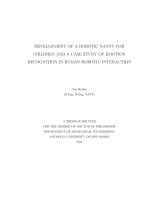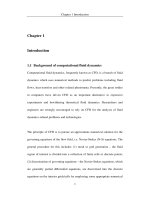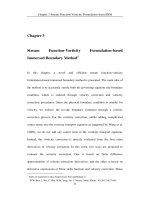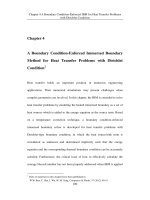Characterization of Asiatic lily genotypes for flowering and quality parameters under protected conditions
Bạn đang xem bản rút gọn của tài liệu. Xem và tải ngay bản đầy đủ của tài liệu tại đây (251.1 KB, 7 trang )
Int.J.Curr.Microbiol.App.Sci (2018) 7(9): 75-81
International Journal of Current Microbiology and Applied Sciences
ISSN: 2319-7706 Volume 7 Number 09 (2018)
Journal homepage:
Original Research Article
/>
Characterization of Asiatic Lily Genotypes for Flowering and Quality
Parameters under Protected Conditions
S.Y. Chandrashekar1*, B. Hemla Naik2, Balaji S. Kulkarni3 and R.C. Jagadeesha4
1
Department of Floriculture and Landscape Architecture, College of Horticulture, Mudigere,
Chikmagalur-577132, Karnataka, India
2
Department of Horticulture, College of Agriculture, Navile, Shivamogga - 577225,
Karnataka, India
3
Department of Floriculture and Landscape Architecture, College of Horticulture, GKVK,
Bangalore-65, Karnataka, India
4
Department of CIB, UHS, Bagalkot, Karnataka, India
*Corresponding author
ABSTRACT
Keywords
Asiatic lily,
Genotypes, Floral
parameters,
Protected condition
Article Info
Accepted:
04 August 2018
Available Online:
10 September 2018
The present investigations were carried out in the experimental block of the department of
Floriculture and Landscape Architecture, College of Horticulture, Mudigere, Chikmagalur,
Karnataka to characterize the Asiatic lily genotypes for flowering and quality of cut
flowers under naturally ventilated polyhouse. The days taken for flower bud emergence
were significantly differed among all the genotypes of Asiatic lily. The genotype Telisker
was the earliest to show colour by taking (35.00 days) whereas, Ercolania (48.67 days) was
late for expressing colour in its flower. The genotype Pirandeu was the earliest to show
colour by taking minimum number of days followed by Telisker. The genotype Merluza
(19.51 cm) followed by Courier (19.34 cm) produced significantly bigger sized flowers
than any other genotypes. The genotypes viz., Pirandeu, CEB Dazzle, Dazzle, Courier,
Pavia and Tresor recorded maximum number of spikes per square meter(24.00) while, the
genotype Batistero recorded the minimum number (16.67). The genotype Pirandeu
extended its vase life maximum up to (12.37 days) and found significantly superior over
other genotypes and it was found to be on par with Pavia (12.17 days) whereas, the
minimum number of days was recorded in Navona (7.73 days).
bulbiferum existing in nature. The genome
size of Lilium belongs to one of the largest in
plant kingdom.
Introduction
The Lilies belongs to genus Lilium of
Liliaceae family, consist of about 80-100
species distributing in the northern hemisphere
(Eurasia and North America continent). All
Lilium species are diploid (2n=2x=24), except
some triploid forms of L. tigrinum and L.
The two important distribution centers of lily
are South-East Asia (China, Korean peninsula
and Japan) and North America are with 61 and
21 species, respectively and the number of
75
Int.J.Curr.Microbiol.App.Sci (2018) 7(9): 75-81
native European and Eurasian species is
approximately 10 (Van et al., 2011).
genotypes. The genotype Telisker was the
earliest to show colour by taking (35.00 days)
whereas, Ercolania (48.67 days) was late for
expressing colour in its flower. The days taken
for 50 per cent flowering varied significantly
among different genotypes of Asiatic lily. The
genotype Pirandeu was the earliest to put forth
50 per cent flowering (43.00 days) which was
followed by genotype Courier (44.00 days),
while the genotype Merluza (64.00 days) was
late to put forth 50 per cent flowering. These
variations for flower bud initiation may be
attributed
to
genetic
make-up
and
physiological
differences
among
the
genotypes as reported earlier by Dhiman
(2003), Sindhu (2006) and Pandey et al.,
(2010).
Materials and Methods
The present investigations were carried out in
the experimental block of the department of
Floriculture and Landscape Architecture,
College
of
Horticulture,
Mudigere,
Chikmagalur, Karnataka to characterize the
Asiatic lily for cut flower yield and quality
under naturally ventilated polyhouse. Fifteen
Asiatic lily genotypes were procured from
M/S Florence Flora, Bangalore and M/S Sheel
Biotech, New Delhi. The name and colour of
these fifteen genotypes are presented in the
Table 1. The experiment was laid out in
randomized complete block design (RCBD)
with three replications. The size of the
experimental plot was 2.5 m x1 m (2.5 m2).
The healthy, uniform sized (12-14 cm
diameter) bulbs of fifteen Asiatic lily
genotypes were planted at a depth of 10 cm in
each plot with 30 X 15 cm spacing.
The genotype Pirandeu was found to be the
earliest to put forth 50 per cent flowering
which was followed by genotype Telisker.
The variation in floral characters may be
attributed to the genetic make-up of plants.
Wide variation in floral parameters has also
been reported by Dhiman (2003), Sindhu
(2006), Chitra and Rajamani (2009) and
Pandey et al., (2010). The days taken to
flowering was also affected by duration of
cold storage of bulbs. As the cold storage was
extended the variation in time to flowering
decreased. The results are in agreement with
the findings of Wilfret and Raulston (1971).
The data pertaining to different flower quality
parameters viz., flower bud diameter (mm),
flower diameter (cm), stalk length (cm) and
vase life (days) are presented in Table 3 and
Figure 2.
The recommended dose of FYM @ 4 kg per
m2 and N, P and K (10:15:20 g/m2) fertilizers
were applied in the form of urea (46.40% N),
rock phosphate (28.00 % P2O5), muriate of
potash (60.00% K2O), respectively. The basal
dose of 50 per cent of NPK was applied at the
time of planting, while remaining 50 per cent
of NPK was applied in 5 split doses at
different crop growth stages. A secondary
nutrient like Calcium was applied as basal
dose in the form of Calcium Ammonium
Nitrate to soil at the rate of 30 g/m2.
The results indicated that, significant
differences were observed for bud diameter of
different Asiatic lily genotypes. It was
maximum in the genotype Merluza (25.96
mm) and was found on par with Courier
(23.92 mm) followed by Mestre (23.60 mm)
whereas, Tresor recorded minimum (17.46
mm) bud diameter.
Results and Discussion
The data pertaining to flowering characters
like days taken to colour visibility and days
taken to 50 per cent flowering are furnished in
Table 2 and Figure 1. The days taken for
visibility of colour in flower bud from
planting varied significantly among different
76
Int.J.Curr.Microbiol.App.Sci (2018) 7(9): 75-81
Table.1 Colour characteristics of 15 Asiatic lily genotypes
Genotypes
Advantage
Bright Diamond
CEB Dazzle
Dazzle
Courier
Mestre
Telisker
Batistero
Pirandeu
Merluza
Fangio
Pavia
Ercolania
Tresor
Navona
Colour
Orange
White
Yellow
Yellow
White
Light pink
Orange
Red
Dark pink
White
Red
Yellow
White
Orange
White
Source
M/S Florence Flora, Bangalore
M/S Florence Flora, Bangalore
M/S Sheel Biotech, New Delhi
M/S Florence Flora, Bangalore
M/S Florence Flora, Bangalore
M/S Florence Flora, Bangalore
M/S Sheel Biotech, New Delhi
M/S Sheel Biotech, New Delhi
M/S Sheel Biotech, New Delhi
M/S Sheel Biotech, New Delhi
M/S Sheel Biotech, New Delhi
M/S Sheel Biotech, New Delhi
M/S Florence Flora, Bangalore
M/S Sheel Biotech, New Delhi
M/S Sheel Biotech, New Delhi
Table.2 Performance of different Asiatic lily genotypes for flowering
parameters under protected condition
Treatment
T1
T2
T3
T4
T5
T6
T7
T8
T9
T10
T11
T12
T13
T14
T15
Genotypes
Advantage
Bright Diamond
CEB Dazzle
Dazzle
Courier
Mestre
Telisker
Batistero
Pirandeu
Merluza
Fangio
Pavia
Ercolania
Tresor
Navona
SEm±
C.D. (P=0.05)
Days to colour visibility
43.33
42.67
46.67
44.67
37.67
45.00
27.00
35.67
35.00
43.33
44.67
46.00
48.67
45.67
45.33
0.95
2.74
77
Days to 50 per cent flowering
57.33
57.00
62.67
61.33
44.00
61.33
45.33
53.33
43.00
64.00
62.67
63.00
63.00
60.67
58.67
1.29
3.73
Int.J.Curr.Microbiol.App.Sci (2018) 7(9): 75-81
Table.3 Performance of different Asiatic lily genotypes for flower
quality under protected condition
Treatment
T1
T2
T3
T4
T5
T6
T7
T8
T9
T10
T11
T12
T13
T14
T15
Genotypes
Advantage
Bright Diamond
CEB Dazzle
Dazzle
Courier
Mestre
Telisker
Batistero
Pirandeu
Merluza
Fangio
Pavia
Ercolania
Tresor
Navona
SEm±
C.D. (P=0.05)
Flower bud
diameter (mm)
19.20
19.86
18.85
17.75
23.92
23.60
18.73
20.34
19.19
25.96
19.54
18.87
19.05
17.46
18.58
1.53
4.42
Flower
diameter (cm)
17.71
16.97
17.69
17.15
19.34
18.09
18.28
16.70
18.27
19.51
16.41
18.79
18.68
17.27
16.41
0.58
1.67
Stalk length
(cm)
50.57
67.77
65.63
61.63
54.47
75.87
67.43
59.67
49.77
56.57
57.87
48.93
52.53
45.00
34.77
2.01
5.84
Vase life
(days)
8.27
9.25
10.33
10.37
9.37
9.27
11.27
10.23
12.37
10.23
8.23
12.17
8.20
8.23
7.73
0.59
1.72
Table.4 Performance of different Asiatic lily genotypes for flower
Yield under protected condition
Treatment
T1
T2
T3
T4
T5
T6
T7
T8
T9
T10
T11
T12
T13
T14
T15
Genotypes
Advantage
Bright Diamond
CEB Dazzle
Dazzle
Courier
Mestre
Telisker
Batistero
Pirandeu
Merluza
Fangio
Pavia
Ercolania
Tresor
Navona
SEm±
CD@ 5%
Number of florets/spike
2.80
3.20
4.87
4.40
2.80
3.93
3.47
2.93
5.00
2.93
3.20
4.53
3.93
3.60
4.27
0.26
0.75
78
Number of spikes/m2
23.33
23.33
24.00
24.00
24.00
23.33
23.67
16.67
24.00
22.00
21.33
24.00
23.67
24.00
19.33
0.97
2.80
Int.J.Curr.Microbiol.App.Sci (2018) 7(9): 75-81
Fig.1 Performance of different Asiatic lily genotypes for flowering
Parameters under protected condition
Fig.2 Performance of different Asiatic lily genotypes for vase life
Grown under protected condition
79
Int.J.Curr.Microbiol.App.Sci (2018) 7(9): 75-81
The variations in the bud diameter might be due
to the thickness of petals and also due to the
inherent characters. Varying amount of
differences was recorded among the different
Asiatic lily genotypes for flower stalk length. It
was maximum in the genotype Mestre which
was superior over other genotypes.
attractiveness for a longer period and also might
be due to inherent differences among the
genotypes. Similar such results were also
obtained by Song et al., (1996) and Susan
(2003).
Variation in vase life could also be attributed to
the increased accumulation of carbohydrates
since, these genotypes could produce more
number of leaves and higher chlorophyll
content, which might have led to increased
photosynthesis and increased carbohydrates.
Similar variations for vase life were also
observed previously by Mahesh (1996) and
Krishnappa et al., (2000).
The stalk length is very important parameter in
Asiatic lily cut flowers. It is one of the
characters which decide the quality of cut
flowers. This difference among the genotypes
of Asiatic lily might be due to their genetic
characters of particular genotype.
Significant differences were observed with
respect to flower diameter among the genotypes
studied. The genotype Merluza (19.51 cm)
followed by Courier (19.34 cm) produced
significantly bigger sized flowers than any other
genotypes. The smaller sized flowers were
produced by Navona (16.41 cm).
The best cultivar is decided on the basis of
number of buds per spike and its quality. The
data recorded on yield components viz., number
of florets per spike and number of spikes per
square meter as influenced by different Asiatic
lily genotypes are presented in the Table 4. The
perusal data presented revealed that, the
significantly higher (5.00) number of florets
recorded in the genotype Pirandeu and was
superior compared to all other genotypes
studied and the genotype Advantage (2.80)
recorded minimum number of florets.
Varying amount of differences was recorded
among the different Asiatic lily genotypes for
flower stalk length. It was maximum in the
genotype Mestre (75.87 cm) which was superior
over other genotypes, whereas it was recorded
minimum in Navona (34.77 cm).
The significant differences were found within
the genotypes of Asiatic lily for number of
spikes per square meter. The number of spikes
per square meter in different genotypes ranged
from 16.67 to 24.00. The genotype Pirandeu,
CEB Dazzle, Dazzle, Courier, Pavia and Tresor
recorded maximum number of spikes per square
meter (24.00) while, the genotype Batistero
recorded the minimum number (16.67). The
increase in flower yield might be attributed by
more number of leaves per plant and
chlorophyll content in the leaves that would
have resulted in production and accumulation of
maximum photosynthates and their utilization
for build-up of new cells, thereby increasing the
production of more number of buds per spike.
The significantly higher number of florets
recorded in the genotype Pirandeu and was
superior compared to all other genotypes
studied. However, no significant differences
were found within the genotypes of Asiatic lily
for number of spikes per square meter. Wide
variation in floral parameters has been reported
by Dhiman (2003), Sloan and Harkness (2005),
Rashmi (2006), Sindhu (2006) and Chitra and
Rajamani (2009).
The genotype Pirandeu extended its vase life
maximum up to (12.37 days) and found
significantly superior over other genotypes and
it was found to be on par with Pavia (12.17
days) whereas, minimum number of days was
recorded in Navona (7.73 days).This could be
due to the presence of more number of buds in
flower spike which help the spike to retain
The results are in accordance with the findings
of Pandey et al., (2010) and Rajivkumar et al.,
(2010). The variation in the flower yield might
80
Int.J.Curr.Microbiol.App.Sci (2018) 7(9): 75-81
be due to their genetic makeup. The results are
in accordance with the findings of Vikas (2009),
Pandey et al., (2010) and Rajivkumar et al.,
(2010).
under Jammu conditions. Environment
and Ecology, 28(2): 775-776.
Rajivkumar, Bidyut, C., and Patel, V. V., 2010,
Evaluation of Asiatic lilium under subtropical mid hills of Meghalaya. J. Orn.
Hort., 13(4): 257-260.
Rashmi, L., 2006. Evaluation of promising
hybrids of gladiolus, M.Sc. (Agri.) Thesis,
Uni. Agric. Sci., Dharwad.
Sindhu, S. S., 2006, Evaluation of Lilium
cultivars under North Indian conditions.
Haryana J. Hort. Sci., 35(3&4): 270.
Sloan, R. C. and Harkness, S. S., 2005. Hybrid
lily cultivar evaluation. Mississippi
Agriculture & Forestry Experiment
Station Information Bulletin, 419: 267275.
Song, C., Bang, C., Chung, S., Kim, Y., Lee, J.
and Lee, D., 1996, Effects of postharvest
pretreatments and preservative solutions
on vase life and flower quality of Asiatic
hybrid lily. Acta Hort., 414: 277-285.
Susan, H, S., 2003. Role of sugar in the vase
solution on postharvest flower and leaf
quality of Oriental Lily ‘Stargazer’, Hort
Science, 38(3): 412-416.
Van, T., Jaap, M., Arens, M. S., Ramanna, A.,
Shahin, N. K., Xie, A., Lim, M. A. and
Rodrigo, B., 2011. Lilium. Chapter In:
Kole, C. Wealth of Wild Species: Genetic,
Genomic and Breeding Resources
Volume 9 - Plantation and Orn. Crops.
Springer-Verlag Series, in press.
Vikas, H. M., 2009. Performance of dahlia
(Dahlia variabilis L.) accessions under
transitional zone of Karnataka. M.Sc.
Thesis, University of Horticultural Sci.,
Dharwad.
The flowering and quality parameters are
recorded maximum in the genotype Mestre
which was superior over other genotypes. The
stalk length is very important parameter which
decides the quality of cut flowers. The
differences among the genotypes of Asiatic lily
for flower yield and quality might be due to
their genetic characters of particular genotype.
The significantly higher number of florets
recorded in the genotype Pirandeu and was
superior compared to all other genotypes
studied.
References
Chitra, R. and Rajamani, K., 2009. Evaluation
of different glory lily (Gloriosa superba
L.) genotypes for vegetative, floral and
yield characters. Agric. Sci. Digest, 29
(3): 190-193.
Dhiman, M. R., 2003. Evaluation of Lilium
hybrids under Kullu conditions. J. Orn.
Hort. (New Series), 6 (2): 154-155.
Krishnappa, K. S., Shivreddy, N. and
Anjanappa, 2000. Effect of floral
preservatives on the vase life of Carnation
cut flower cultivars. Karnataka J. Agric.
Sci., 13(2): 395-400.
Mahesh, K., 1996. Variability studies in
Carnation (Dianthus caryophyllus L.).
M.Sc. Thesis, University of Agric. Sci.,
Bangalore.
Pandey, R. K., Dogra, S., Jamwal, S. and Bhat,
D., 2010, Performance of Asiatic lily
How to cite this article:
Chandrashekar, S.Y., B. Hemla Naik, Balaji S. Kulkarni and Jagadeesha, R.C. 2018.
Characterization of Asiatic Lily Genotypes for Flowering and Quality Parameters under Protected
Conditions. Int.J.Curr.Microbiol.App.Sci. 7(09): 75-81.
doi: />
81









